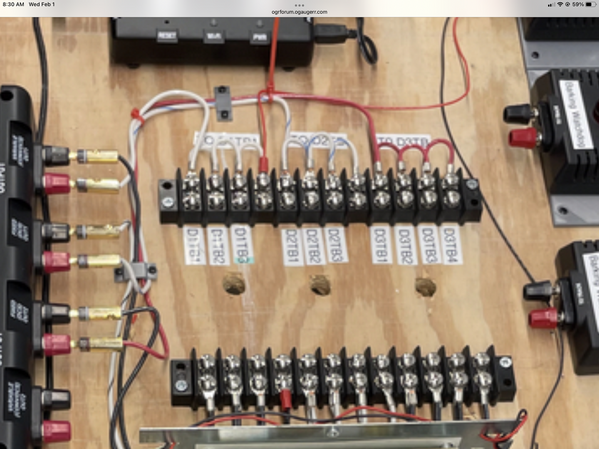Let me start with DCS was up and running on what track I had put down for testing. It was a substantial amount (>30 feet) ran two ps3 diesel engines on same track using DCS handheld remote controlling both at will. Things seemed to work as designed so the next step was to connect Lionel legacy to the system so I could use the MTH remote to control a couple of Lionel/ERR upgraded engines as well as the MTH diesels. Hooking up all the correct cables and LCS serial2 box I was able to get the lionel upgraded diesel (Illinois Central 2363 post war unit) to run under MTH DCS handheld remote. Sounds all good... well then murph the surf shows up! I put the mth diesels back on the track, power up and they are dead as door nails! ![]() So of course what was the last thing I did? Lionel Legacy added. So I removed the legacy fro the system and still dead as door nails, I hit the read button and it shows 1 tiu and 3 Aiu's and no DCS engines detected.
So of course what was the last thing I did? Lionel Legacy added. So I removed the legacy fro the system and still dead as door nails, I hit the read button and it shows 1 tiu and 3 Aiu's and no DCS engines detected. ![]() After removing two of the three input/outputs so there was just fixed 1 input/output, same thing would happen, nothing! Ok so I take my spare TIU which both of my TIU's are rev. L , and a separate piece of track and put my mth SW-1 penn switcher on and it is inactive. Hit read and it shows 1 TIU 0 AIU's and no engines connected. Just to see if anything would work I set up the DCS consumer loader and copied the handheld remote to the pc. That worked! Then I down loaded the sound file from the engine (SW-1) to the PC and that was succesful (114 minutes later) . I swapped engines with the second ps3 engine and upon powering it up, there was life! Not sure why yet... ok with the remote I was able to shut it down, start it up, move forward, change direction, move backwards, so it seemed to be working. I put it back on the main layout and it appears to still function! ok good news! Murphy comes back and I hit read, just to see what happens. it finds 1 TIU 3 AIU's and no dcs engines found! And now the engine is in the inactive list and cannot be controlled. So I power everything down, track, TIU, AIU, and handheld remote. Power it back up and it all functions again! However this time I start the engine moving forward and then hit read as it is moving. Yup no dcs engines found, the engine that is still moving down the track is no in the inactive list and cannot be controlled! I shut down power to everything which was the only way I could stop the moving engine. Powered it all back up and it all works again. I leave the read button alone and shutdown engine and turn off power.
After removing two of the three input/outputs so there was just fixed 1 input/output, same thing would happen, nothing! Ok so I take my spare TIU which both of my TIU's are rev. L , and a separate piece of track and put my mth SW-1 penn switcher on and it is inactive. Hit read and it shows 1 TIU 0 AIU's and no engines connected. Just to see if anything would work I set up the DCS consumer loader and copied the handheld remote to the pc. That worked! Then I down loaded the sound file from the engine (SW-1) to the PC and that was succesful (114 minutes later) . I swapped engines with the second ps3 engine and upon powering it up, there was life! Not sure why yet... ok with the remote I was able to shut it down, start it up, move forward, change direction, move backwards, so it seemed to be working. I put it back on the main layout and it appears to still function! ok good news! Murphy comes back and I hit read, just to see what happens. it finds 1 TIU 3 AIU's and no dcs engines found! And now the engine is in the inactive list and cannot be controlled. So I power everything down, track, TIU, AIU, and handheld remote. Power it back up and it all functions again! However this time I start the engine moving forward and then hit read as it is moving. Yup no dcs engines found, the engine that is still moving down the track is no in the inactive list and cannot be controlled! I shut down power to everything which was the only way I could stop the moving engine. Powered it all back up and it all works again. I leave the read button alone and shutdown engine and turn off power.
Can anyone help with this??? The SW-1 is on a test track with different TIU and is still dead to the world, although the pc thinks it downloaded its sound file. I am totally new to DCS, I did look through the troubleshooting and this isn't mentioned. I have read several posts alluding that the no engine found is low DCS signal from TIU however from both TIU's??? The second TIU is literally brand new, almost never used.
So questions in my mind are: On power up it reads the engine, but hitting the read button the engine is not found. What is the difference???
And should I try to flash the engine that is dead operationally but seems to transfer files fine.
Any help it appreciated! Thanks in advance. Sorry for being LONG Winded


















